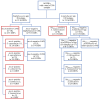Presence of Methicillin-Resistant Staphylococci and Carbapenemase-Positive Acinetobacter Isolates on Surfaces in German Dog Daycare Facilities and Correlation with Cleaning Practices
- PMID: 39591342
- PMCID: PMC11599097
- DOI: 10.3390/vetsci11110568
Presence of Methicillin-Resistant Staphylococci and Carbapenemase-Positive Acinetobacter Isolates on Surfaces in German Dog Daycare Facilities and Correlation with Cleaning Practices
Abstract
Many bacteria, including methicillin-resistant staphylococci and opportunistic pathogens such as Acinetobacter (A.) species, in particular members of the A. calcoaceticus-A. baumannii (Acb) complex, are known to survive in environmental settings. This increases the risk of bacterial spreading and transmission to animals and humans, especially in institutions with a high animal population density. This study aimed to identify the presence of multidrug-resistant (MDR) staphylococci and Acinetobacter species in dog daycare facilities (DDFs). The surfaces of 16 DDFs were sampled and information about cleaning practices was obtained. After microbial identification, the detected isolates were investigated by multiplex PCR for antimicrobial resistance genes. In 200 location samples, 38 staphylococci and 109 Acinetobacter spp. isolates were identified. Methicillin-resistant genes were confirmed in 18 staphylococci isolates from four DDFs, including Staphylococcus (S.) equorum, S. saprophyticus, S. cohnii, S. lentus, and S. haemolyticus. Eight A. radioresistens isolates comprising the blaOXA-23 carbapenemase gene and seventeen isolates belonging to the Acb complex were also isolated. This is the first investigation for MDR pathogens in DDFs, a close human-animal interaction environment. Though the role of DDFs in the transmission and spreading of MDR bacteria is not known, the findings should contribute to the public awareness and underscore the necessity of adequate cleaning protocols.
Keywords: Acinetobacter species; antimicrobial resistance; dog daycare facilities; methicillin-resistant staphylococci; one health; risk factors; transmission.
Conflict of interest statement
Stephanie Forbes and Anja Roethig have been, and Maren Doelle is working for AniCura; the study has been funded by an independent scientific grant from AniCura. Ellen Prenger-Berninghoff and Christa Ewers are working at the Institute of Hygiene and Infectious Diseases of Animals, Faculty of Veterinary Medicine, Justus Liebig University Giessen; the study has been additionally funded by internal financial sources.
Figures



References
-
- Magiorakos A.-P., Srinivasan A., Carey R.B., Carmeli Y., Falagas M., Giske C., Harbarth S., Hindler J., Kahlmeter G., Olsson-Liljequist B. Multidrug-resistant, extensively drug-resistant and pandrug-resistant bacteria: An international expert proposal for interim standard definitions for acquired resistance. Clin. Microbiol. Infect. 2012;18:268–281. doi: 10.1111/j.1469-0691.2011.03570.x. - DOI - PubMed
-
- Morris D.O., Loeffler A., Davis M.F., Guardabassi L., Weese J.S. Recommendations for approaches to meticillin-resistant staphylococcal infections of small animals: Diagnosis, therapeutic considerations and preventative measures. Clinical Consensus Guidelines of the World Association for Veterinary Dermatology. Vet. Dermatol. 2017;28:304-e369. doi: 10.1111/vde.12444. - DOI - PubMed
Grants and funding
LinkOut - more resources
Full Text Sources
Miscellaneous

